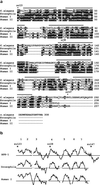APH-1 is a multipass membrane protein essential for the Notch signaling pathway in Caenorhabditis elegans embryos
- PMID: 11792846
- PMCID: PMC117381
- DOI: 10.1073/pnas.022523499
APH-1 is a multipass membrane protein essential for the Notch signaling pathway in Caenorhabditis elegans embryos
Abstract
Early embryonic cells in Caenorhabditis elegans embryos interact through a signaling pathway closely related to the Notch signaling pathway in Drosophila and vertebrates. Components of this pathway include a ligand, receptor, the presenilin proteins, and a novel protein, APH-2, that is related to the Nicastrin protein in humans. Here we identify the aph-1 gene as a new component of the Notch pathway in Caenorhabditis elegans. aph-1 is predicted to encode a novel, highly conserved multipass membrane protein. We show that aph-1 and the presenilin genes share a similar function in that they are both required for proper cell-surface localization of APH-2/Nicastrin.
Figures



References
-
- Artavanis-Tsakonas S, Rand M D, Lake R J. Science. 1999;284:770–776. - PubMed
-
- Greenwald I. Genes Dev. 1998;12:1751–1762. - PubMed
-
- Kimble J, Simpson P. Annu Rev Cell Dev Biol. 1997;13:333–361. - PubMed
-
- Kopan R, Goate A. Genes Dev. 2000;14:2799–2806. - PubMed
-
- Yu G, Nishimura M, Arawaka S, Levitan D, Zhang L, Tandon A, Song Y Q, Rogaeva E, Chen F, Kawarai T, et al. Nature (London) 2000;407:48–54. - PubMed
Publication types
MeSH terms
Substances
LinkOut - more resources
Full Text Sources
Other Literature Sources
Molecular Biology Databases

